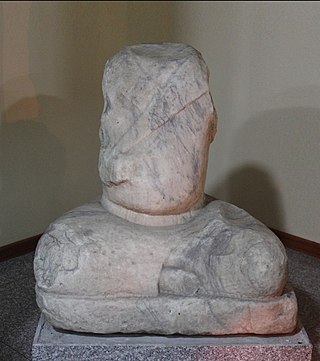
Bilge Qaghan was the fourth Qaghan of the Second Turkic Khaganate. His accomplishments were described in the Orkhon inscriptions.
Ilterish Qaghan was the founder of the Second Turkic Khaganate.

The Türgesh or Türgish were a Turkic tribal confederation. Once belonging to the Duolu wing of the Western Turkic On Oq elites, Türgeshes emerged as an independent power after the demise of the Western Turks and established a khaganate in 699. The Türgesh Khaganate lasted until 766 when the Karluks defeated them. Türgesh and Göktürks were related through marriage.

The Iron Gate, is a defile between Balkh and Samarkand. It breaks up the mountains which extend from the Hisar range south towards the Amu Darya. In ancient times it was used as the passage between Bactria and Sogdia and was likely of great importance to any power in the region. Its name comes from the belief that an actual gate, reinforced with Iron, stood in the defile. It is located to west from Boysun, Surxondaryo Region. Although its exact location is debatable, it is usually considered to be the 3-kilometre (1.9 mi) pass on the road from Samarkand (Uzbekistan) to Balkh (Afghanistan) and close to Qarshi city. According to historian Lev Gumilev its present name is "Buzgala".
Qapaghan or Qapghan Qaghan was the second khagan of the Second Turkic Khaganate during Wu Zetian's reign and was the younger brother of the first kaghan, Ilterish Qaghan.
The Basmyls were a 7th- to 8th-century Turkic nomadic tribe who mostly inhabited the Dzungaria region in the northwest of modern-day China.
Suluk, Sul-lu or Sulu (?-738) was a Türgesh tribal leader and a Qaghan who defended Transoxiana against Umayyad conquest in the early 8th century.
Tardu or Tardush Yabghu was the second yabghu of the Western Turkic Khaganate, and ninth Khagan of the First Turkic Khaganate (599–603). He was the son of Istämi.
The Tariat inscriptions appear on a stele found near the Hoid Terhyin River in Doloon Mod district, Arkhangai Province, modern-day Mongolia. The stele was erected by Bayanchur Khan of the Uyghur Khaganate in the middle of the eighth century.
Yukuk Shad reigned in the final days of the Western Turkic Khaganate. His name Yukuk means "owl", according to Gumilyov, or means "venerable", according to Gabain. His full title was 乙毗咄陆可汗 or Yipi Duolu Kehan.

The Second Turkic Khaganate was a khaganate in Central and Eastern Asia founded by Ashina clan of the Göktürks that lasted between 682–744. It was preceded by the Eastern Turkic Khaganate (552–630) and the early Tang dynasty period (630–682). The Second Khaganate was centered on Ötüken in the upper reaches of the Orkhon River. It was succeeded by its subject Toquz Oghuz confederation, which became the Uyghur Khaganate.
Kutluk Yabgu Khagan was one of the last yabghus (rulers) of the Second Turkic Khaganate.
Özmiş Khagan - was the last penultimate khagan of the Second Turkic Khaganate (Göktürks).
Kulun Beg - was a Turkic (Göktürk) ruler who tried to sustain the Second Turkic Khaganate in vain.
Qutluğ Säbig Qatun was the khatun (queen) and then hansha of the Second Turkic Khaganate. She served as regent during the minority of Tengri Qaghan in 734-741.
Külüg Sibir or Baghatur Khagan was a ruler of the Western Turkic Khaganate (empire) in the 7th century. He was probably Tardu's son and the governor of the northern provinces of the empire during the reigns of his nephews.

The Tonyukuk inscriptions, also called the Bain Tsokto inscriptions are Turkic inscriptions of the 8th century located in Nalaikh, Ulaanbaatar, Mongolia. They are one of the oldest written attestations of the Turkic language family, predating the Orkhon inscriptions by several years.
Sir-Kıvchak were a Turkic people whose existence is controversial and who were proposed to be precursors to the Kipchaks who settled in East Europe in the 10th century.
Saqal was a Turgesh Qaghan. According to Yuri Zuev, he was a Manichaeist so that his name was possibly derived from Manichean theonym Sakla which means "Creator of the World". Other reconstructions are Saqal and Soq.
The Battle of Sayan Mountains was a major battle between the Göktürks and Yenisei Kyrgyz Khaganate followed by a successful battle led by Tonyukuk.




